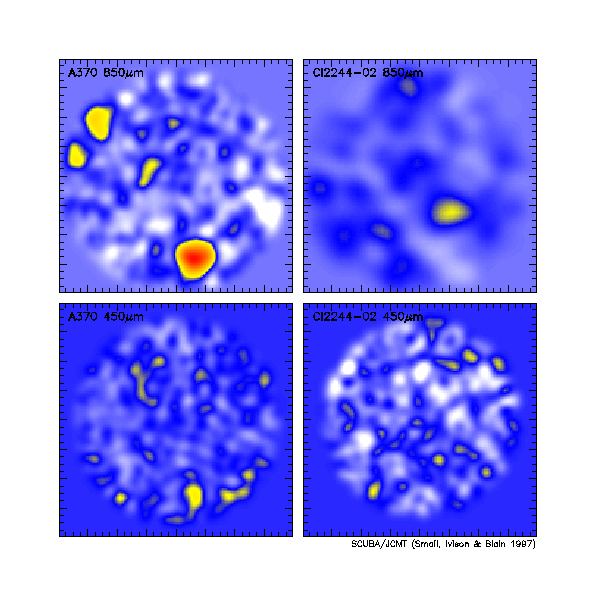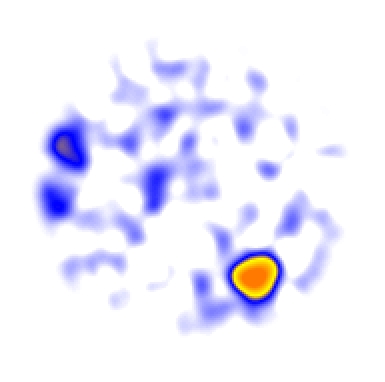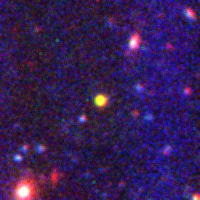
Deep 850um (top-left) and 450um (bottom-left) maps of the rich cluster A370
(z=0.37) taken with the SCUBA
bolometer array on the 15-m JCMT, Hawaii.
These are the first deep sub-millimeter maps of the distant Universe
ever taken and they show a number of sub-mm sources detected at 850um.
These objects are seen in the sub-mm because the dust within them is
reprocessing UV and optical star-light and emitting large quantities of
radiation in the sub-mm. Only one of these 850um sources (the
brightest) is seen at 450um and the constraints this provides on the
redshifts of the sources indicates that the majority of these
objects are likely to lie at z>>1. If this is the case then these
represent very luminous and strongly star-forming galaxies
(`proto-galaxies'?). Optical surveys of the distant Universe have
failed to uncover this population, probably due to the high optical
obscuration caused by the dust. The high surface density of the
sub-mm sources indicates that the population being missed by the
optical surveys could account for over half the star-formation in
the distant Universe. These data were acquired in
collaboration with Rob
Ivison and Andrew Blain.

The images on the right are 850um and 450um maps of the compact cluster lens Cl2244-02
(z=0.33). We detect two faint sources at 850um in this field, again
they are weak or undetected at 450um indicating that they probably lie
at high redshift. All the maps are roughly 180 arcsec in diameter and the major
tick marks show 10 arcsec.
New images for the press release. These show the 850um SCUBA map of
A370 (right) and a true-color image of the same field (left)
constructed from BRI images. Links to the images in different formats are given here:
Optical JPEG,
Optical TIFF,
SCUBA JPEG,
SCUBA TIFF.


CAPTION:These two images show different views of the same
region of sky containing the gravitational cluster-lens Abell 370. On
the left we have a true colour `optical' image made up of blue, red and
near-infrared images taken with the 3.6-m Canada France Hawaii
Telescope by Dr Jean-Paul
Kneib of Toulouse Observatory. The optical image shows a giant
gravitational arc seen through the centre of the cluster of galaxies,
this is a image of a background galaxy distorted and magnified by the
foreground cluster lens. A number of other distorted images of visible
across the frame - as well as many of the galaxies actually within the
cluster which appear yellow. There are obviously are a large number
of very faint galaxies visible in this image, but it is impossible to
tell which are the distant, young galaxies which are crucial
for studying galaxy formation and evolution.
However, on the right is the submillimetre SCUBA
map of the same field, although this detects only a few objects these
are all likely to be the dusty, young galaxies which are need to
test models of galaxy formation. Thus SCUBA's
submillimetre observations are critical for understanding the
evolution of galaxies.
 The SCUBA 850um map of the cluster A1835 overlayed on a composite
UBI ground-based image to show the optical counterparts to two
of the bright SCUBA sources (the z=2.56 starburst galaxy on the left
of the image and the bright central cluster galaxy at z=0.25 in the middle
of the field). The brightest SCUBA source in this field (on the right)
has no bright optical counterpart and is likely to be a highly obscured
galaxy at high redshifts.
The SCUBA 850um map of the cluster A1835 overlayed on a composite
UBI ground-based image to show the optical counterparts to two
of the bright SCUBA sources (the z=2.56 starburst galaxy on the left
of the image and the bright central cluster galaxy at z=0.25 in the middle
of the field). The brightest SCUBA source in this field (on the right)
has no bright optical counterpart and is likely to be a highly obscured
galaxy at high redshifts.

Two objects selected from a CCD imaging
survey of 0.25 sq. degrees of sky in UBI. These two objects have
stellar profiles and relatively blue (B-I) colors, what sets them apart
from other objects in the fields is their extremely red (U-B) colors
considering their (B-I). The two objects have: I=18.4, (B-I)=2.5 and
(U-B)>4.7; I=19.8, (B-I)=2.1 and (U-B)>3.3. Where the (U-B) values
are 1 sigma upper limits given no detection (U>25-25.5). The typical
errors on the B/I photometry are 0.05 mag. The image below shows the
IBU images (from left to right) for each object. Their total absence
from the U image indicates that the Lyman break in these objects lies
redward of this passband. Combined with their relatively blue
(B-I) colors this argues for them lying at z>3, and given their luminosities
and compact nature these are likely to be QSOs. The two images at the
bottom show `true' color representations of the UBI exposures of
A2261 and A1758, coded as U=blue, B=green and I=red. The yellow star-like object in the center of each frame is the QSO. Update:
Spectroscopy with the WHT by Alastair Edge and Richard Ellis shows
these two objects to be at z=3.85 and z=3.72, the z=3.85 having
two damped Lyman-alpha features and a Lyman limit systems.





Last Modified: April 25th, 1997. [Netscape 2.0]










